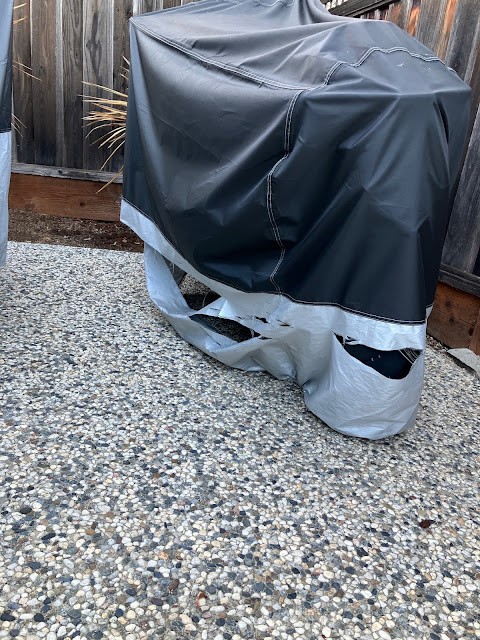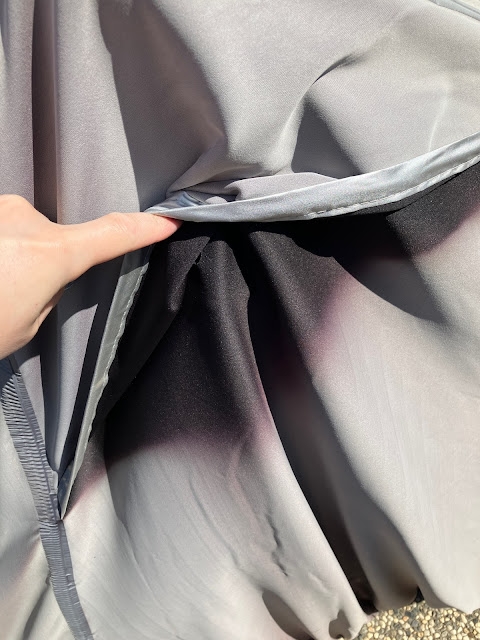Generally speaking, motorcycles are designed to get wet. They're designed to have the sun shining down on them. They're outdoor machines engineered to survive the elements. Sort of.
The problem is that they have bits made of plastic, and that plastic, despite being chock full of UV stabilizers, doesn't last forever when the sun is a deadly lazer.
Luckily motorcycle covers exist. Their only purpose in life is to be resistant to the elements. They shed rain, they scoff at UV, they...
... sometimes don't hold up as well as one might expect.
These motorcycle covers are made out of two types of fabric. The upper fabric is a fairly generic oxford cloth, which is (supposed to be) a polyester fabric with a polyurethane coating. It's held up reasonably well. The lower fabric seems to just be a fairly plain, probably polyester cloth with no special coating. It is most definitely not resistant to rain, UV, or heat for that matter. It will quite cheerfully melt onto a hot exhaust pipe, for instance.
Anyway, the damage we see here is due mostly to UV exposure causing the fabric fibers to degrade. I started noticing this a while back, and in fact I even invested in a much more expensive motorcycle to replace the one that was on Orthrus, my R65. For clarity, the subject of today's mending is the cover for Gregg, my CB650F.
This cover is made out of a much higher quality fabric that is resistant to rain, UV...
Well ok, the fabric is holding up pretty well under UV; the black dye maybe not so much.
Anyway, the point is I had a spare motorcycle cover laying around that used to be on Orthrus, and which was still composed of at least 60% usable fabric, so I figured it was time to make use of it.
To begin the operation, we must first make an incision.
The dearly departed organ donor must also be dissected.
I didn't really have a long enough straight edge to make this cut, so I ended up improvising a little.
Well, no going back now. Time to turn this pile of fabric back into a motorcycle cover. For that job, we use my new favourite sewing implement: the overlock/coverstitch machine.
After a few minutes of threading and configuring all the knobs and cams, the settings look pretty good on a test piece.
This marks the first time I've done an overlock with the cutter engaged, which is its own little adventure.
But enough talk, have at you!
For stitching the pieces together I just used a wide 3-thread overlock stitch. I'm basically just sewing a really wide tube that I chopped up out of one motorcycle cover onto the bottom of the other cover to replace the fabric I trimmed off of it, in case you've lost track of where I'm going with this.
I'm also sewing on an elastic hem, too.
For this one I'm using a 4-thread overlock, and I've also switched to the elastic foot which has a little friction roller that you feed the elastic through. This pre-stretches it, which automatically causes the sewn elastic to gather the fabric, as you can see above on the test piece. Very, very convenient.
Really, once you have it set up, you just have to buzz around the hem and it all just magically falls into place.
The original construction only had two relatively short bits of elastic at the front and rear. I decided to put elastic all the way around because quite frankly it was easier than stopping part way, especially since I needed to hem the whole thing anyway, and I also wanted the elastic to actually be useful. It really wasn't, before.
Anyway, the results are really quite good if I do say so myself.
The original construction also had a set of buckle straps that went under the motorcycle, but now that I've got a proper amount of elastic on there it really doesn't need them, so I didn't bother sewing them back on. I can still go back later and add them if I feel the urge, but that seems a bit unlikely at this point.
Of course, I still have two other motorcycle covers with shitty, UV-baked fabric on them, so I'll need to do some careful considering about what my plan for them will be.
In the meantime, I've found the proper home for the silver fabric I removed.
Off it goes to break down into microplastics and poison all the marine life in the great pacific garbage patch. Goodbye, shitty fabric. You will not be missed.












No comments:
Post a Comment